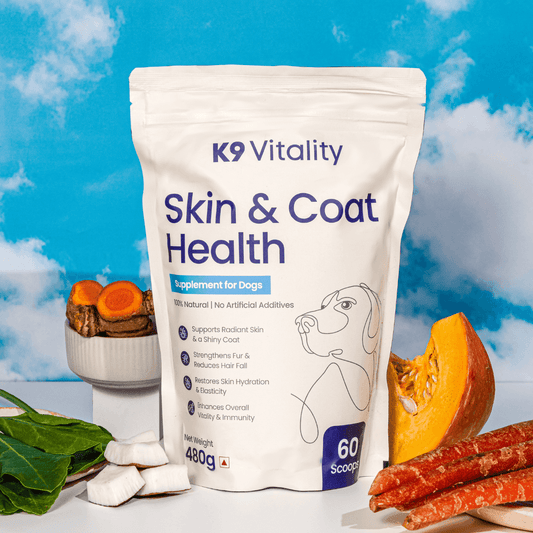
How to Read Dog Supplement Labels: A Complete Guide for Pet Parents by K9 Vitality
Share
Introduction: Do You Really Know What’s in Your Dog’s Supplement?
Have you ever picked up a dog supplement bottle and found yourself lost in a sea of scientific terms, confusing percentages, and unrecognizable ingredients? Do you really know what you're giving your furry best friend? If not, you're not alone. Many dog parents want the best for their pets but are unsure how to interpret supplement labels. That's where K9 Vitality steps in.
Reading dog supplement labels is more than just a routine check; it's a vital skill that can significantly affect your dog’s health. With an ever-growing pet supplement market, understanding what you're purchasing and why it matters has never been more crucial.
In this comprehensive guide, K9 Vitality will walk you through everything you need to know about dog supplement labels—from decoding ingredient lists to identifying misleading marketing claims. We aim to empower pet parents with the knowledge to make informed, safe, and beneficial choices for their dogs.
Why Reading Supplement Labels Matters
Just like with human supplements, not all dog supplements are created equal. The quality, sourcing, and formulation of ingredients vary widely. Understanding labels helps you:
- Avoid harmful or unnecessary ingredients
- Ensure your dog gets appropriate dosages
- Spot high-quality products with proven efficacy
- Prevent allergic reactions or negative interactions
- Get better value for your money
The Anatomy of a Dog Supplement Label

To read a label effectively, you must understand its core components. Here's what you will typically see:
1. Product Name and Branding
Often the flashiest part, but not always the most informative. Watch for words like "natural," "premium," or "vet-approved"—these terms are often marketing tools, not quality indicators.
2. Active Ingredients
These are the ingredients intended to provide health benefits. Pay close attention to:
- Dosage amounts (e.g., mg per serving)
- Scientific names vs. common names (e.g., Ascorbic Acid = Vitamin C)
- Purpose (Is it for joint health? Coat? Digestion?)
3. Inactive Ingredients
Used for flavor, texture, or preservation. These can include:
- Binders and fillers (e.g., cellulose)
- Flavorings (e.g., beef liver powder)
- Preservatives (e.g., mixed tocopherols)
4. Guaranteed Analysis
Especially in nutritional supplements, this shows the minimum or maximum levels of key nutrients (e.g., protein, fat, fiber).
5. Serving Size and Directions
Make sure you understand how much to give and how often.
6. Cautions and Warnings
Important for dogs with specific health conditions or those on medications.
7. Manufacturer Details
Look for transparency: reputable companies provide contact information, manufacturing origin, and certification details.
Red Flags to Watch Out For
❌ Proprietary Blends
These often list multiple ingredients without specifying individual dosages, making it hard to assess effectiveness.
❌ Vague or Unsupported Claims
Phrases like "boosts immunity" or "detoxifies" without clinical backing are suspect.
❌ Artificial Additives and Fillers
Ingredients like BHA, BHT, and artificial colors/flavors should raise concern.
❌ No Third-Party Testing or Certifications
Look for seals like NASC (National Animal Supplement Council), which indicate higher standards of quality control.
How to Verify Ingredient Quality
Understanding ingredient lists is not enough; you also need to assess quality:
- Source Matters: Are the ingredients organic, non-GMO, or sustainably sourced?
- Bioavailability: Can the ingredient actually be absorbed by your dog’s system?
- Scientific Backing: Is there research supporting the ingredient's efficacy in dogs?
- Human-Grade Standards: Products made in human-grade facilities are generally safer.
Decoding Marketing Lingo: What's Real and What's Hype
Terms Often Used:
- "All-Natural": Doesn't guarantee safety or effectiveness.
- "Veterinarian Recommended": Sometimes based on paid endorsements.
- "Organic": Only valid if certified by a recognized body.
- "Clinically Proven": Ask to see the study!
What Actually Matters:
- Clear ingredient transparency
- Scientifically supported formulations
- Company reputation and reviews
K9 Vitality’s Top Tips for Choosing the Right Supplement

- Research the Brand: Look for transparency, certifications, and customer feedback.
- Read the Label Thoroughly: Don’t rely on the front label alone.
- Consult Your Vet: Especially if your dog has health conditions or is on medication.
- Start with a Trial: Introduce supplements gradually and monitor for changes.
- Store Properly: Keep supplements in a cool, dry place to maintain efficacy.
Conclusion: Empower Yourself as a Pet Parent
Being a responsible pet parent means more than just giving your dog love and affection. It involves making informed choices about what goes into their body. Reading and understanding dog supplement labels is a powerful tool in your canine care arsenal.
With K9 Vitality as your guide, you can confidently navigate the world of supplements, ensuring your dog receives only the highest-quality products tailored to their needs. Don’t fall for flashy marketing or vague promises. Instead, trust in your ability to decipher the label, assess the product, and consult professionals when needed.
Because when it comes to your dog’s health, knowledge isn’t just power—it’s protection.






